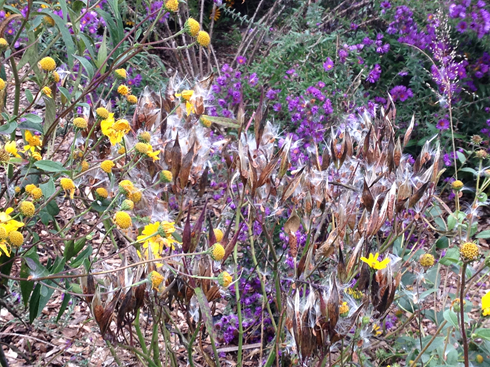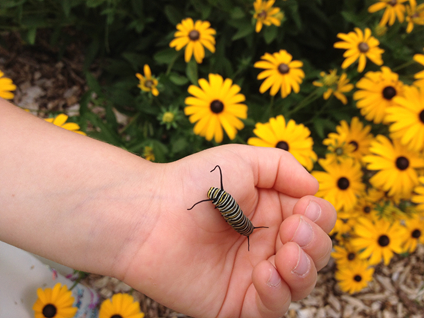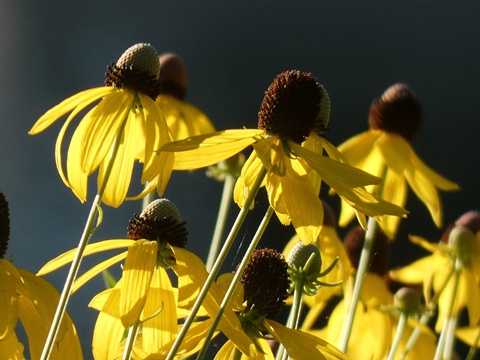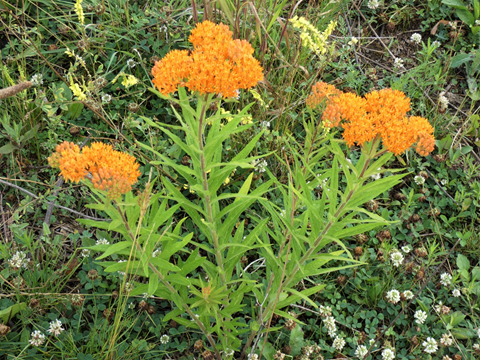
Home > Newsletters > GreenFriends Newsletters
| Home | Source Reduction | Friends of Green Friends | Newsletters |
| Gardening | Resources | What You Can Do | Embracing The Trees |
| In Support of Prairies and Pollinators |
| "Mother Earth is serving us; the sun, the moon, and the stars all serve us. What can we do in return for their selfless service?" - Amma from 108 Quotes on Nature |
 |
|
Like most American children, I learned during my elementary years of the deeply sad story of rainforest destruction. Along with my classmates, I sold "Save the Rainforest" T-shirts and asked my parents to purchase recycled paper in an effort to help. Years later, while pursuing a B.A. in environmental studies, I continued to explore the themes of resource use and habitat conservation. Along my research path, I came across the depressing fact that nearly half of tropical rainforests have been destroyed. However, what shocked me most from my research findings was not what has been happening in the Amazon, but what had occurred in my own Midwest region "backyard." Imagine North America, 200 years ago. Tall grass prairies once covered 170 million acres, sweeping across the continent from the Rocky Mountains to east of the Mississippi River, and from Saskatchewan all the way south to Texas. An icon of the mid-western landscape, the tall grass prairie is heralded by ecologists as one of the most complicated and diverse ecosystems in the word. Shockingly, humans have altered this landscape so drastically that experts estimate that only about 1% of tall grass prairie remains. One percent. Like a scene straight out of Dr. Seuss’ The Lorax, I suddenly realized what 'we,' as collective humans of past and present, have done to the prairie. Here we stand, like the young boy in the story, listening in agonizing captivation to the Once-ler narrating his sad tale, however; in our case, the seeds he tosses to outstretched hands in hope are not Truffula seeds, but big bluestem, aster, Indian grass, butterfly weed, prairie dropseed… |
| In the past few years, MA Center Chicago (MACC) has been blessed to catch some of those seeds. As Amma says, "When compassion arises within us, we will sincerely wish to help and protect all beings." (108 Quotes on Nature).
Directly inspired by how our beloved Amma cares for nature, MACC residents and local devotees have been lovingly planting seeds of hope. One long-term resident has slowly transformed his entire front and backyard into a prairie restoration project, much to the delight of his fellow human, plant, and animal residents. When a new retention pond was constructed on the ashram property a few years back, care was taken to establish a prairie plant community in a wide swath surrounding the pond. This area is a haven for wildlife, and the strong, deep roots of the prairie grasses and forbs anchor the soil in place and help prevent erosion on the slope. |
 Retention pond |
| In 2020, an additional 2,000 square foot area was established with pollinator plants adjacent to the pond, and a new 2,800 square foot pollinator garden was seeded by sevites at the Y road junction at MACC. As one resident said, "We wait for spring and new plant growth with the excited anticipation of expecting parents!" |
|
Located on the MACC campus, the Green Friends Montessori School (GFMS) has also caught the prairie restoration bug. In the winter of 2020, GFMS applied for and received the Illinois Schoolyard Habitat Action Grant in order to expand the school’s pollinator garden. The grant we received allowed GFMS to nearly triple the size and species richness of the existing pollinator garden on the school playground, expanding it to over 900 square feet in size. Planting took place during the spring of 2020, with families visiting the site to plant on a rotating basis to remain in line with local COVID-19 protocols. Most of the plants flowered during this first summer, and an abundance of pollinators were observed in the garden, including a variety of bees, wasps, butterflies, and more. When children returned to school in August, they began exploring the garden with great enthusiasm and interest. In spite of some challenges related to COVID-19, the project went very smoothly, the plants grew quickly and are healthy, and care of the garden is incorporated into the classes’ regular visits to the garden. |
 GFMS garden |
| Prairie gardens and restoration efforts not only help restore a vital ecosystem, they also provide important habitat and food sources for pollinators. The dominant flora in a prairie ecosystem includes grasses, which are wind pollinated, and wildflowers (or forbs), which are pollinated by animals including bees, beetles, flies, butterflies, moths, and hummingbirds.
Even establishing a small backyard pollinator garden will help support healthy insect and hummingbird populations in your area. Migrating monarch butterflies and ruby-throated hummingbirds also rely on finding rest stops along their migration routes - maybe your backyard will be visited by them next fall! Pollinators and prairies are inextricably linked. Healthy pollinator populations support ecosystem health, leading to increased biodiversity and resilience, and decreased encroachment of invasive species. Pollinators are also key components of a healthy human food system, as we have pollinators to thank for "bringing to fruit" approximately one third of our agricultural crops. |
|
Top |
|
By now you may be wondering, what can the average citizen do to support prairies and pollinators? Here are a few tips to get started:
|
|
|
|
As Amma says, "Look at the beauty of nature. Living harmoniously with nature will in itself bring happiness and contentment." (108 Quotes on Nature). May we all strive to care for the earth and see unity and beauty in all of creation. |
|
||
|
For more information on Prairie Gardening, please visit: https://plantnebraska.org/file_download/inline/d4298e4c-cb9e-45db-b64f-c400b4668b85 For more information on Pollinators, please visit: https://extension.entm.purdue.edu/publications/POL-7/POL-7.pdf Paurnami Engelking - MA Center Chicago |
Read about nurturing well-being with Maother Nature's Love from the Q1 2021 newsletter >>
| Home | Source Reduction | Friends of Green Friends | Newsletters | Resources | What You Can Do | Contact Us |
For more information, e-mail info@greenfriendsna.org |
||||||


